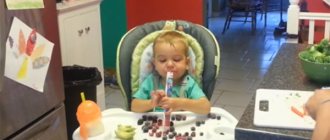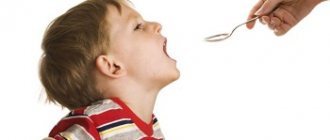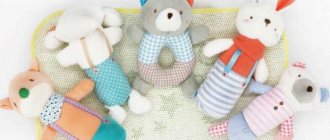We study the instructions on the packaging
The first step is to study the packaging. Even if you are an experienced mother, it is still worth reading the information from the manufacturer to refresh your memory once again. The pack indicates what temperature the water should be, how much of it is needed (in milliliters) to dilute the dry formula, and how much of the feeding formula itself a newborn needs for one meal in measuring spoons.
Mixed feeding
A mixed feeding system for your child will help you transition comfortably and safely from breastfeeding to artificial feeding. Mixed feeding involves feeding the newborn with mother's milk and special formulas. At the same time, baby food does not exceed fifty percent of the infant’s total diet. Gradually increasing the percentage of formulas, and as if “displacing” breast milk, the mother transfers the child to artificial feeding. This nutrition system also involves a “reverse move” to breastfeeding, when a woman, reducing the amount of baby food, returns the child to full breastfeeding.
Water matters
To prepare the mixture, it is best to use special baby water. It has less mineralization than regular dining room. To prepare the mixture, the water does not need to be boiled, but only heated to approximately 40 °C. There are mixtures that, according to the instructions, should be filled with hotter water. Pay special attention to this! Try to give your baby a mixture close to 37 °C (body temperature).
Always check it additionally before feeding by dropping the finished product on the back of your hand - the liquid should be practically unnoticeable. If the temperature of the mixture exceeds the desired temperature, you can cool the bottle in cold water. There are also special baby bottles that have a temperature indicator.
What temperature should formula be for newborns?
Newborn babies need special care. Artificial feeding is a whole ritual, and it is important for the mother to follow strict rules and doctor’s recommendations. The dishes must be sterile; you must remember the dosage and frequency of feeding. The pediatrician observing your child should tell you all this.
The food itself is prepared quite simply. The bottle is sterilized using a special device, non-hot boiled water is poured in (not boiling water, so that the water retains maximum nutrients), the required amount of dry powder is added with a measuring spoon and thoroughly mixed until the lumps are completely dissolved.
Then it is heated using a special device - a warmer - to the required temperature of the mixture for the newborn. If it is not there, use the already described water bath technique, when the bottle with the mixture is lowered into a container with hot water.
It is worth remembering that food cannot be prepared in advance. Do this immediately before feeding, and be sure to throw out the leftovers without leaving them for later. If you are going for a walk, use a special thermos. You should not save on your baby’s health - buy only fresh formula in trusted stores.
Warm, but not hot!
You can achieve the desired water temperature by mixing hot water with cooled water (do not mix boiled and unboiled water, even if it is purchased, bottled). You can keep a bottle of water in the warmer before feeding (be sure to remove the pacifier). A high-quality thermos or thermopot, which maintains a high temperature, is very convenient for these purposes.
What should you not feed if you have a cold?
When you have a fever, do not overload your stomach. During illness, exclude from the child’s diet:
- fatty dairy products,
- yeast dough, baked goods,
- red meat,
- fatty fish,
- chocolate,
- new, previously untried dishes and flavor combinations,
- pickled vegetables,
- products containing vinegar.
Avoid foods with strong tastes, spices, sour and salty foods. They irritate the stomach and can increase inflammation in the throat.
Modern doctors do not recommend feeding children meat broths: when cooked, all the harmful substances from meat get into them. Offer your baby a light vegetable or milk soup. When the temperature drops, you can feed your baby tender chicken soup with a second broth.
In the middle of the night
How to feed a baby formula at night? For night feeding, it is advisable to prepare everything in advance. The bottle warmer is very convenient and keeps the desired temperature. You can put a bottle with the required amount of water in it, and next to it - a portion of the dry mixture. Then at night all you have to do is pour the mixture into the water, put a nipple on the bottle and shake the food vigorously. You can pour warm water into a thermos or keep it
There is boiling water in a thermos to add to a bottle of cold water. Try to accurately measure the required amount of mixture and water so that you don’t have to do it in the middle of the night. And under no circumstances leave the prepared mixture in the heater for several hours! Before feeding, be sure to drop the prepared mixture onto the inside of your arm - you need to make sure that the mixture does not burn the baby. Don't worry, very soon all your actions will become a habit.
Attention!
Never use a microwave oven to prepare or heat infant formula. Microwaves often heat foods unevenly, so some of the formula may be too hot for your baby.
Why can’t you give your child hot porridge, and what should the temperature of the food be?
What happens in a child’s body when either “ice” or “flame”, or even both, gets inside? Pediatricians know the answer to this question, and they are willing to share their knowledge with you so that you do not make common mistakes.
Food temperature: hunger after cold
As you know, many kids enjoy ice cream. Meanwhile, their mothers do not even realize that food that is too cold is contraindicated for children under adolescence.
The fact is that the production of gastric juice decreases when cold food arrives, and this does not allow the stomach to fully digest the food to the point where the intestines can fully absorb it. As a result, unprocessed food begins to ferment in the intestines, because it also does not secrete the enzymes necessary for its absorption, since the food arrived there in an “unfamiliar” state. This is where colitis, enterocolitis, and gastritis originate.
In addition, hunger occurs faster after a cold meal than after a warm meal. The fact is that warm food is digested in about 3 hours, while cold food “flies out” after 1–1.5 hours, which means that a baby who often eats cold food or drinks cold drinks will be constantly hungry. As a result, in addition to problems with the gastrointestinal tract, his diet will be disrupted, which can also cause various diseases.
Food temperature: harm instead of hardening
If you think that ice cream or cold water can harden a child’s body, then you are making a mistake. Low food temperature can only lead to hypothermia and provoke the development of infection. After all, when cold food enters the throat and follows down to the stomach, it causes cooling of all mucous membranes, including the respiratory system. At this moment, dangerous microbes, such as streptococci, living in the nasal and throat sinuses, begin to actively multiply, because hypothermia is stress for the body, during which the immune defense weakens. As a result, an inflammatory process begins: the throat turns red, plaque appears, and the temperature rises.
But then how should you harden your baby? This will be helped by gargling with water at room temperature in the morning and evening.
Food temperature: destructive heat
Food hotter than 60 °C should not enter the child’s stomach - any pediatrician will say so. High temperature has a very negative effect on the gastric mucosa. That is why both the first and second courses prepared for a child should be moderately warm - approximately 40–50 °C.
If hot food often enters the baby’s stomach, then first the mucous membrane of the esophagus and stomach receives a burn, followed by swelling. It will be painful for the child to swallow the next pieces of food. In addition, after microburns, ulcers first appear on the damaged mucosa, and then scars. If there are too many scars, a dangerous narrowing of the esophagus can occur.
To bring your food to the optimal temperature, wait 15 minutes after you pour freshly cooked soup or porridge into a bowl. This is especially easy to do in the morning: while the porridge is cooling, the baby will have time to wash himself and do exercises. By the way, while preparing for breakfast, he will secrete gastric juice, which will help him properly absorb food.
Food temperature: such different foods
Feeding your baby food and drinks at a comfortable, that is, moderately warm, temperature is a vital necessity. But what about in the summer, when it’s hot and you want to sip something cold, or in the winter, when it’s frosty and the body needs to warm up with hot dishes? During such seasons, nutritionists and gastroenterologists recommend focusing not on the temperature of the dishes, but on the types of foods that are divided into cold and warm.
For example, apples are a cooling fruit, while oranges are a warming fruit. That’s why you should get carried away with apples in the summer, and don’t forget about oranges in the winter. In winter, you can add cinnamon to moderately hot tea to keep the baby warm longer (this is allowed for children over three years old). Or put a spoonful of honey in warm tea - this biologically active product perfectly warms the body. And in the summer, use lemon and mint as cooling additives.
On a winter morning, before leaving the house, it is good to give your baby tea with ginger and porridge with a “warming” banana. And in the summer, offer him homemade lemonade at room temperature and porridge or cottage cheese with an apple - this way the cooling effect will last longer. But you shouldn’t give cottage cheese in the evening, because it is a cooling product, and at night the body temperature already drops, since at this time all processes in the body slow down.
At the same time, the temperature of dishes during peak seasons, for example, in intense heat or severe cold, can be correspondingly either slightly lowered or increased, that is, food can be a little colder than moderately warm in the summer, and a little hotter than moderately warm in the winter.
Expert opinion
Elena Reztsova, Ph.D. honey. Sci., pediatrician, deputy. Chief physician of ON CLINIC, Moscow
- According to pediatricians, both hot and cold foods are dangerous to the health of babies. Children's bodies react poorly to aggressive temperatures, both high and low. In both cases, the mucous membrane of the internal organs experiences serious stress, after which illness, weakness, or a long recovery may occur.
- It is also harmful to feed a child with contrasting food at one time, first giving a warm cutlet, and then offering to wash it down with cold juice or ice cream. In this case, illness cannot be avoided, because after warming the stomach tissues with warm food, a cold drink or ice cream causes a sharp spasm. Gastric juice is not released, and food does not have time to be digested. And it must enter the intestines at least partially digested, because there the process of its absorption and final separation into nutrients and waste is completed.
- In an undigested form, food begins to ferment, which causes cramps and pain in the abdomen. This is why a child’s body tolerates a combination of foods of opposite temperatures much more difficult than a dish of one temperature – either hot or cold.
Useful tips
To reduce the possible risk to your baby’s health when consuming foods and drinks at “extreme” temperatures, listen to the advice of experts.
- If you cannot refuse a child who persistently asks for ice cream, try to minimize the consequences of eating it. For example, give your baby melted ice cream.
- Also try to add fresh berries and fruits (mashed or pieces), chopped nuts, and cereal cookies to the saucer with this delicacy. They contain fiber and pectins, which help absorb nutrients from the ice cream.
- Even in hot summer weather, instead of cold water, give your baby water at so-called room temperature. If it is stored in a home refrigerator, then warm the bottle under running hot water before giving it to your baby.
- If you bought water from the refrigerator during a walk, do not give it to your little one right away. First, warm the bottle in your palms or hold it in the sun until the water reaches room temperature.
It is a fact
If you are in a hurry and need to feed your baby quickly, you should not blow on a dish that is too hot in an attempt to reduce its temperature. You still run the risk of burning the baby’s oral mucosa and esophagus and causing unpleasant consequences. In case of force majeure, it is better to use the two-plate rule. Cool the bottom of one plate in a bowl of cold water, put soup or porridge in it, then cool the bottom of the second plate, transfer food there, etc. until it cools down.










